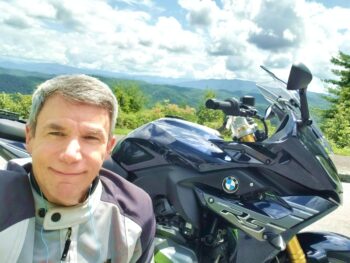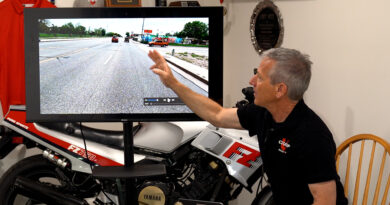Farewell old friend
Having recently written about the exhilaration of adding a motorcycle to my stable (“New Bike Fever”) and the intense preoccupation with making it truly mine following such an event (“Farklemania”), it’s only fitting to complete this story arc with the bittersweet experience of selling a bike I was once thrilled to acquire and upon which I lavished a great deal of time, effort and money. Riders become attached to their machines to varying degrees, depending on details of their personality, circumstances, the unique characteristics of the bike and what special meanings those hold for the owner. Some motorcyclists don’t get very attached to their motorcycles, while others develop a powerful bond with each and every one they possess. Here we’ll explore some factors involved in the relationships between flesh-and-blood human beings and their steel-and-aluminum companions. Such factors are especially apparent during the separation process, when the prospect of loss brings them into sharpest focus.
 What follows won’t apply to everyone. Riders and racers who view their motorcycles as mere tools for getting certain jobs done (e.g., commuting, competing) may value machines that serve them well, but don’t necessarily have much of an emotional connection to them. Such motorcyclists are focused on the ends, not the means; the bike itself is of secondary importance. As long as it’s functioning well, it disappears behind a utilitarian goal. Whatever emotional investment exists is directed at that purpose, not the conveyance toward it. Also, there are people within and outside the world of motorcycling for whom attachment to inanimate objects simply makes no sense. These folks reserve affection for their relationships with other people, and perhaps pets, although this wording suggests it’s a conscious, deliberate decision. While we may try to squelch or disregard our object-oriented sentimentality, I don’t think its existence is really a matter of choice. Those of us who imbue our possessions with powerful emotional meaning do so because of how we’re built, not what we choose. Try as we might, none of us has much control over what moves our heart and what doesn’t.
What follows won’t apply to everyone. Riders and racers who view their motorcycles as mere tools for getting certain jobs done (e.g., commuting, competing) may value machines that serve them well, but don’t necessarily have much of an emotional connection to them. Such motorcyclists are focused on the ends, not the means; the bike itself is of secondary importance. As long as it’s functioning well, it disappears behind a utilitarian goal. Whatever emotional investment exists is directed at that purpose, not the conveyance toward it. Also, there are people within and outside the world of motorcycling for whom attachment to inanimate objects simply makes no sense. These folks reserve affection for their relationships with other people, and perhaps pets, although this wording suggests it’s a conscious, deliberate decision. While we may try to squelch or disregard our object-oriented sentimentality, I don’t think its existence is really a matter of choice. Those of us who imbue our possessions with powerful emotional meaning do so because of how we’re built, not what we choose. Try as we might, none of us has much control over what moves our heart and what doesn’t.
Over the past half-century, I’ve owned about 40 motorcycles, with as many as nine at once. Parting with a bike has almost always been fraught with serious ambivalence. Even when my riding interests shifted and I had to sell the current motorcycle to pay for a replacement better suited to my evolving tastes, I never wanted to completely give up the unique character and capabilities of the outgoing machine. During a period of almost two decades, my pendulum of craving swung back and forth between on- and off-road riding when I lacked the money and space for more than one motorcycle at a time. In a misguided approach to frugality, I suffered the financial penalties of frequent turnover until I realized it would actually be cheaper to just keep two bikes in my garage simultaneously. (I was never content with the compromise solution of just having a dual-sport, as it would frustrate me no matter where I was on the continuum.) Once I could afford to keep an assortment of more niche-bound motorcycles handy, I still hated letting one go, even when acquiring another of the same genre.
Admittedly, this defies logic. Why would I feel such a sense of loss when the new bike did virtually everything better than the old one? This was certainly the case with the latest arrival and departure. While the ultimate decision to replace one with the other boiled down to this objective functional comparison, it’s the plethora of intangible factors that made the execution sticky. There’s the origin story, for starters. Thirteen years ago, I stumbled upon an absolutely crazy deal on this rare bike that had already been extensively customized in many of the ways I’d have done, myself. It was pristine, and a model I’d been infatuated with since its appearance as a concept bike in the enthusiast press a half-dozen years prior. Exotic enough that I had yet to see one in person locally, it kept getting rave reviews in the media, fanning the flames of my desire from afar. The principle, “Absence makes the heart grow fonder,” was definitely in play. I couldn’t spend the big bucks required for a new one, so I’d regularly scanned online classified ads in hope of nabbing a used one I could afford, but they very seldom appeared and were always gone by the time I reached the seller. This time, I saw the ad minutes after its posting, immediately called the seller, and set up a deal three states away for the next morning. I hooked up my trailer, grabbed cash at the bank on my way out of town, and drove through the night to get this deal done. Not only was it by far the finest example of this machine I’d ever seen, it was being sold at the lowest price with less than a thousand miles on the clock. I was afraid it might be too good to be true, but I went to the extraordinary lengths necessary to find out. It was completely legit. The extremely wealthy owner had a garage the size of my house, densely packed with top-shelf, decked-out motorcycles. He cared more about reclaiming a little floor space than recouping his monetary investment in this bike. It was an utterly surreal fairytale to me, one of those moments when all the stars had come into perfect alignment.
 My acquisition efforts were greatly rewarded. This bike was easily my favorite “of all time”—for a decade. I loved its power, handling, appearance, sound and the brilliant engineering and craftsmanship it displayed. Although I knew I’d never be able to exploit its performance, it fit me like a glove in every way, and allowed me to participate in its sporting grandeur, if mainly in my imagination. I devoted countless hours to meticulous maintenance and many more upgrades, each of which looked and worked like it’d come from that way from the factory. Years later, when I finally completed all this intricate work, I’d almost bought the bike twice, but had no regrets; it was pure magnificence, the hard-earned concrete manifestation of my personal ideal—a dream come to life. However, the dream eventually began to fade…
My acquisition efforts were greatly rewarded. This bike was easily my favorite “of all time”—for a decade. I loved its power, handling, appearance, sound and the brilliant engineering and craftsmanship it displayed. Although I knew I’d never be able to exploit its performance, it fit me like a glove in every way, and allowed me to participate in its sporting grandeur, if mainly in my imagination. I devoted countless hours to meticulous maintenance and many more upgrades, each of which looked and worked like it’d come from that way from the factory. Years later, when I finally completed all this intricate work, I’d almost bought the bike twice, but had no regrets; it was pure magnificence, the hard-earned concrete manifestation of my personal ideal—a dream come to life. However, the dream eventually began to fade…
With age, I grew less enamored of this bike’s ferocious brutality. What had been thrilling became stressful and hard work to manage. There was no way to carry any real luggage on it, and it would be exhausting to ride for more than a day or two, anyway. I was drifting toward a more relaxed, longer distance version of motorcycling. I spent less and less time on it, and more and more time on my other machines, but every once in a while I’d take it out for a spin and revel in its glory. I can’t possibly sell this!! Since I didn’t have to let it go, I didn’t. I might have put no more than a couple hundred miles on it each year by the end, but the ongoing costs of ownership seemed worth it to avoid losing access to the very special experience only this motorcycle could deliver. Whereas I’d never owned any bike for more than a few years, this one stayed with me for 13, and I still hated to see it go.
Who would appreciate it like I did? Would someone else take care of it like I had? I wanted my precious pet to go to a good home! Logic dictated that I must sell it to make room and help fund a replacement more in line with my current needs; it became increasingly hard to justify keeping a bike I wasn’t riding, but which still took up space in my garage and required annual maintenance, registration and insurance premiums. If I wanted another motorcycle I’d actually ride and enjoy more, I had to pass this one on to its next owner. I dragged my feet by pricing it ridiculously high, hoping someone willing to pay that much for it would be a worthy candidate. But as the months dragged on without a sale, I reduced my price to something more reasonable and finally interviewed several potential buyers to determine who was most enamored. I do believe the “winner” is genuinely in love.
This was definitely the most emotionally difficult sale I’ve ever made, but many other motorcycles were very hard to part with, too. The common factors have fallen into several categories. One is the bike’s stature as a true classic; was it recognized by the worldwide motorcycling community as iconic? This “star appeal” would never be enough by itself to endear a machine to me, but it supercharges the initial attraction, magnifies the pride of ownership, and makes me part of history. Landmark motorcycles, like Kawasaki’s first Ninja 900, Honda’s initial CBR900RR and KTM’s original Super Duke weren’t just game-changers I admired at a distance; I knew them intimately as my own.
Something else my stronger attachments have shared is the investment of vast quantities of time, effort and money on repairs and modifications. Whether it was a basket case that required a ton of work just to make it function properly, or a brand new bike already featuring superlative abilities that presented a serious challenge for a would-be improver, the more I poured myself into these projects, the more my connection grew in the process. While I might curse and fume about the (sometimes tremendous) demands and frustrations involved, these ultimately strengthened my attachment in the end. Likewise, when a motorcycle accompanied me through some particularly arduous ordeal, like (unintentionally) touring on the Blue Ridge Parkway in the middle of Hurricane Opal or climbing the boulder-strewn trail up the side of Mount Antero (one of Colorado’s “14-ers”), the bike involved will always occupy a very special place in memory, with an associated sense of gratitude and devotion.
The Ride Inside with Mark Barnes is brought to you by the MOA Foundation. You can join the BMW Motorcycle Owners of America quickly and easily to better take advantage of the Paul B Grant and Clark Luster programs mentioned in this episode.
These relationship-enhancing factors aren’t really all that different from those that contribute to our bonds with other people. Attraction often begins with some sort of notoriety, even if only within a small circle of acquaintances. Some degree of public-facing flashiness grabs our attention, although it may later prove ephemeral or be supplanted by more substantial merits. We invest in connections that excite and gratify us, whether polishing “a diamond in the rough” or further elevating something already idyllic. Such investments reflect our valuation of the bond, and further compound that bond’s worth. When we endure hard times with someone, we also build a stronger relationship with them, especially when we emerge victorious with their help.
 Of course, the converse of all this is true, as well. Our connections to other people weaken when we change in ways that leave us with less in common. One attachment may give way to another that is better equipped to meet our evolving needs. We may miss old relationships for their unique qualities—qualities that can never be precisely replicated elsewhere—yet also recognize we now have a more complete package in someone else, be they friend or lover. Aside from the issue of replacement, there’s also the need for diversification. One-stop-shopping for emotional supplies is a myth. Any set of characteristics we treasure will have a flip side, with some other desirables being mutually exclusive. There will always be compromises and trade-offs; best to have an assortment of options from which to choose for meeting the widest variety of needs. Some relationships will cover more territory than others, but others will tower over the rest in one particular dimension.
Of course, the converse of all this is true, as well. Our connections to other people weaken when we change in ways that leave us with less in common. One attachment may give way to another that is better equipped to meet our evolving needs. We may miss old relationships for their unique qualities—qualities that can never be precisely replicated elsewhere—yet also recognize we now have a more complete package in someone else, be they friend or lover. Aside from the issue of replacement, there’s also the need for diversification. One-stop-shopping for emotional supplies is a myth. Any set of characteristics we treasure will have a flip side, with some other desirables being mutually exclusive. There will always be compromises and trade-offs; best to have an assortment of options from which to choose for meeting the widest variety of needs. Some relationships will cover more territory than others, but others will tower over the rest in one particular dimension.
Obviously, there are very real, very important differences between our attachments to motorcycles and our attachments to friends and family, but there are perhaps more similarities than an outside observer would notice at first glance. Goodbyes, no matter how necessary or unavoidable, can be very difficult in any case.
Mark Barnes is a clinical psychologist and motojournalist. To read more of his writings, check out his book Why We Ride: A Psychologist Explains the Motorcyclist’s Mind and the Love Affair Between Rider, Bike and Road, currently available in paperback through Amazon and other retailers.




